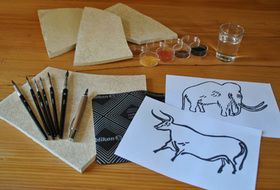Cave painting set for 6 pupils
The cave painting set is designed for groups of up to 6 students.
Painting templates from the world-famous cave of Lascaux, France.
Contents:
- Detailed instructions with 8 different painting templates in A5 format.
- 6 quarry plates, approx. A5, matching our motif templates
- Copy paper for transferring onto the stone slabs
- 4 tins of earth pigments in yellow, red, brown and black
- Binding agent for the natural-based colours
| Aspiration scale: | Medium |
|---|---|
| Time Line: | 2,0 Hours |
The rock paintings of the Lascaux Cave
The discovery
The Lascaux Cave in Montignac in the Dordogne was discovered by chance in 1940 by four young people when one of them was following his dog that had slipped into a hole in the rock. It was thanks to this incident that one of the largest Palaeolithic caves decorated with wall paintings was discovered. This incredible cave, also called the "Sistine Chapel of Prehistory", was closed to visitors in 1963 to protect it, and later, in 1979, became a Unesco World Heritage Site.
Painting
The most impressive section of the Lascaux Cave is undoubtedly the Hall of the Bulls. It contains only paintings because the calcite-covered walls are poorly suited to incised drawings. Particularly spectacular: the size of some illustrations such as the notorious bull, emblem of the Dordogne, with a height of 5.20 metres. Two large aurochs are accompanied by ten wild horses and a mysterious animal called the unicorn. There are also paintings of a bear, which is difficult to make out, and six smaller deer. In addition to the Hall of the Bulls, other parts of the Lascaux cave are decorated with cave paintings, such as the axial side passage where cattle and horses, stags and ibexes can be found. At a height of no less than two and a half metres, there is a wild horse. The animal images cover the entire ceiling of the side corridor and are repeatedly interrupted by signs such as dots, sticks and patterns. The nef or ship features four groups of figures that include bison, cows and deer surrounded by mysterious geometric symbols. The side aisle of the predatory cats is captivating with a group of predators carved into the rock face. In the apse, there is a representation of a reindeer and more than a thousand carvings. Finally, the fountain impresses with one of the most enigmatic of all images: a man with a bird's head.
Colours
Electron microscopic examinations of colour remains confirm a rather diverse colour palette. Black colours correspond with different manganese oxides originating from the environment. Orange, yellow and red colours are due to different iron oxides. The colours were applied directly, without being mixed or thermally altered.
Museum
Open to visitors since 1983, the Lascaux II cave is a replica of the original cave and features the two most famous galleries: the Hall of Animals and the Axial Side Passage. The two museum areas explain the fascinating story of the evolution of man and his tools, placing the Lascaux Cave in prehistoric times.

